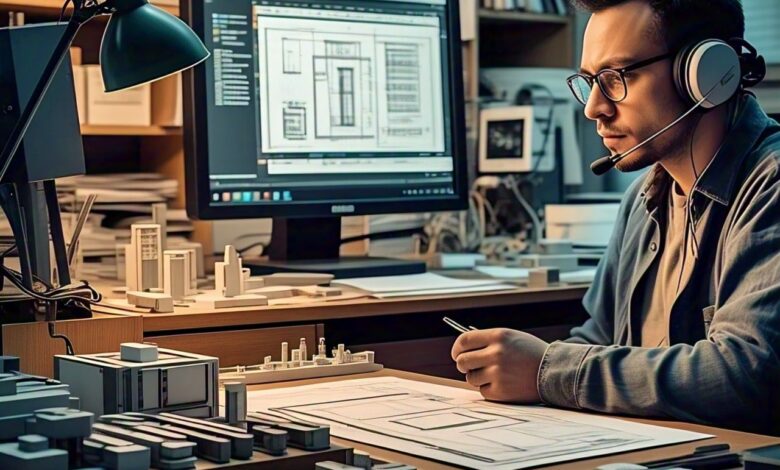Understanding the Role of 2D Drafting in Product Design and Development

2D drafting is an integral component of product design and development. As its primary method for creating detailed technical schematics that direct manufacturing operations, Designing and Drafting techniques help engineers and designers visualize concepts before transitioning them into production, thus eliminating errors while simultaneously cutting costs and streamlining workflow between design-to-production stages.
Engineering drawings provide the basis of any engineering design projects
Engineering drawings rely heavily on 2D drafting to effectively communicate ideas and specifications to manufacturers and builders, including dimensions, annotations, and material details essential for manufacturing. As opposed to three-dimensional models, 2D drafts provide clear documentation without any room for interpretation, providing the basis for various industries like automobile production, aerospace construction, and consumer electronics manufacturing.
How CAD Software Impacts 2D Drafting
Computer-aided design (CAD) software plays an essential part in modern 2D drafting. Designers utilizing such programs as AutoCAD, SolidWorks, and DraftSight use these tools to produce precise yet scalable drawings with minimum effort required—perfect tools to aid collaboration among team members as they easily modify designs with annotations while producing multiple iterations without starting from scratch.
Applications of 2D Drafting in Product Development
2D drafting has long been used in product development across industries. Mechanical engineers often turn to it when creating machine components, gears, and assemblies, while electrical engineers employ it for circuit diagrams, wiring layouts, and schematic development. Architecture designers likewise find it indispensable for floor plans, elevations, and structural blueprint development processes—these applications make 2D drafting an indispensable asset of modern development processes.
Benefits of 2D Drafting for Manufacturing
Manufacturers rely on 2D drafting to ensure accurate production. Fabricators benefit greatly from 2D drawings, as detailed sketches help them understand material requirements, assembly instructions, tolerance levels, and precise measurements and specifications outlined within 2D drafts; these help minimize material waste while increasing efficiency and decreasing costs incurred from errors made when producing physical goods. Therefore, making 2D drafting an integral component of manufacturing.
Comparing 2D and 3D Drafting Systems
Though 3D modeling has grown increasingly popular, 2D drafting remains essential in product development. Drafts are easier for clients and engineers alike to interpret; require less computational power; and offer a clearer representation of dimensions and tolerances than their 3D equivalent. Many industries rely on 2D drawings as technical documentation, as they provide a direct way of conveying design intent without becoming overly complex through 3D visualization.
Accuracy and Precision in 2D Drafting
Two of the key advantages of 2D drafting are its accuracy and attention to detail. Engineers and designers use precise measurements and geometric constraints to draft detailed blueprints that meet exacting specifications, prioritizing accuracy over error reduction and improving overall quality.
Collaboration and Communication in Design Teams
2D drafting provides the means for successful collaboration among design teams, engineers, and manufacturers. Standardized drawings help different departments to collaborate cohesively while all parties involved remain on the same page; engineers can easily review designs before approval while manufacturers provide feedback regarding feasibility—an efficient communication process that leads to improved results while eliminating design flaws.
Drafting 2D Prototypes with Prototyping Tools
Before moving forward with full-scale production, prototypes made from 2D drafts are often developed as preliminary steps. Prototypes help designers test functionality, make modifications, and validate concepts; using 2D drafting as an early stage saves businesses both time and resources while improving product designs—especially crucial in industries where precision and performance are of the utmost importance.
Enhance Design Efficiency through 2D Drafting
2D drafting offers numerous efficiency gains. By providing designers with quick modification capabilities and iterative improvements, this technique speeds the design process and reduces the time needed to bring products to market. Companies using 2D drafting can increase productivity while keeping an edge in their industry.
The Growing Demand for Drafting Services
Businesses often outsource 2D Drafting Services to professional firms for maximum accuracy and efficiency, providing accurate drawings, technical documentation, and drafting solutions tailored to specific industries. Working with experienced drafters allows businesses to optimize design processes while cutting costs while strengthening product development capabilities, as more industries recognize the necessity of precise and detailed drafting. Demand continues to soar for these services across industries worldwide.
Estimators Help Draft and Design Millwork Prototypes
Millwork plays an essential part in construction and interior design projects, necessitating precise measurements and detailed drafts. Millwork Estimators rely on 2D drafting techniques to produce cost estimates, material requirements, and fabrication plans and ensure seamless integration throughout a project by using these services efficiently; their knowledge in both estimating and drafting is integral in streamlining both construction and interior design projects, making them essential members of their respective fields.
2D drafting remains an indispensable element in product design and development, from engineering and manufacturing through construction and prototyping. By employing advanced drafting techniques, businesses can improve accuracy, streamline production, and increase collaboration—an increasingly vital aspect of design and development processes as technology progresses.



